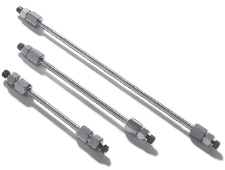SODIUM COLUMNS
 SODIUM AMINO ACID ANALYSIS COLUMNS
SODIUM AMINO ACID ANALYSIS COLUMNS
Ion-exchange chromatography followed by post-column derivatization has been a method of choice for amino acid analysis for many years. Pickering ion-exchange columns allow you to obtain consistent results with sensitivity, stability, selectivity and speed. Sodium columns and buffers systems are designed for amino acids analysis of hydrolyzed samples.
POST-COLUMN CONDITIONS FOR AMINO ACIDS ANALYSIS:
Reagent: Trione®
Reactor: 130 °C, 0.5 mL
Reagent Flow Rate: 0.3 mL/min
Detection:
UV-Vis Detector: λ=570 nm for primary amino acids
λ=440 nm for secondary amino acids
or
Reagent: 300 mg of OPA, 2 g Thiofluor™, 3 mL of 30 %
Brij® 35 solution in 950 mL of OD104
Reactor: 45 °C, 0.15 mL
Reagent Flow Rate: 0.3 mL/min
Detection:
Fluorometer: λex 330 nm, λem 465 nm
The recommended gradient conditions are subject to change without notice. This may happen because of lotspecific changes in the columns, or improvements in the overall method.
The recommended gradient for the column will always be included in the column package, and it supersedes the information in this catalog. Use the program recommended on the column data sheet for the initial testing.
The column oven temperature programming gives additional flexibility when optimizing methods. Using a temperature gradient allows the user to improve separation, shorten analysis time and fine-tune the method for detecting compounds of interest.

